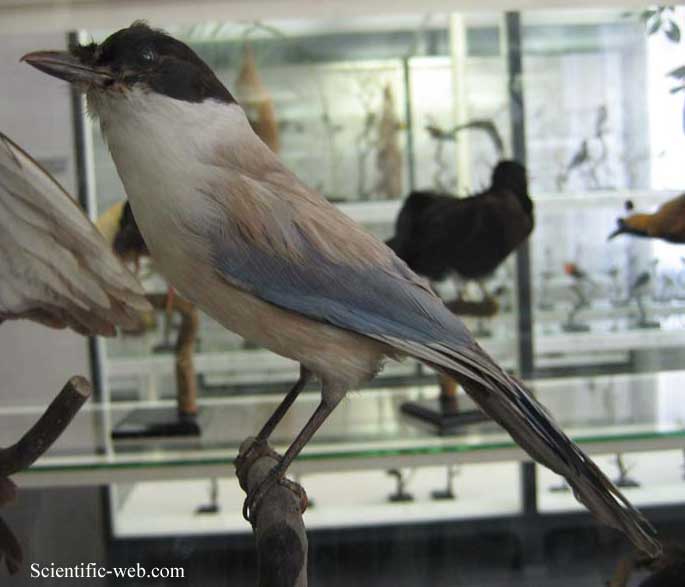
Cyanopica cyanus , Photo: Michael Lahanas
Superregnum: Eukaryota
Cladus: Unikonta
Cladus: Opisthokonta
Cladus: Holozoa
Regnum: Animalia
Subregnum: Eumetazoa
Cladus: Bilateria
Cladus: Nephrozoa
Superphylum: Deuterostomia
Phylum: Chordata
Subphylum: Vertebrata
Infraphylum: Gnathostomata
Megaclassis: Osteichthyes
Cladus: Sarcopterygii
Cladus: Rhipidistia
Cladus: Tetrapodomorpha
Cladus: Eotetrapodiformes
Cladus: Elpistostegalia
Superclassis: Tetrapoda
Cladus: Reptiliomorpha
Cladus: Amniota
Classis: Reptilia
Cladus: Eureptilia
Cladus: Romeriida
Subclassis: Diapsida
Cladus: Sauria
Infraclassis: Archosauromorpha
Cladus: Crurotarsi
Divisio: Archosauria
Cladus: Avemetatarsalia
Cladus: Ornithodira
Subtaxon: Dinosauromorpha
Cladus: Dinosauriformes
Cladus: Dracohors
Cladus: Dinosauria
Cladus: Saurischia
Cladus: Eusaurischia
Subordo: Theropoda
Cladus: Neotheropoda
Cladus: Averostra
Cladus: Tetanurae
Cladus: Avetheropoda
Cladus: Coelurosauria
Cladus: Tyrannoraptora
Cladus: Maniraptoromorpha
Cladus: Maniraptoriformes
Cladus: Maniraptora
Cladus: Pennaraptora
Cladus: Paraves
Cladus: Eumaniraptora
Cladus: Avialae
Infraclassis: Aves
Cladus: Avebrevicauda
Cladus: Pygostylia
Cladus: Ornithothoraces
Cladus: Ornithuromorpha
Cladus: Carinatae
Parvclassis: Neornithes
Cohors: Neognathae
Cladus: Neoaves
Cladus: Telluraves
Cladus: Australaves
Ordo: Passeriformes
Subordo: Passeri
Infraordo: Corvida
Superfamilia: Corvoidea
Familia: Corvidae
Genus: Cyanopica
Species: Cyanopica cyanus
Subspecies: C. c. cyanus – C. c. japonica
Name
Cyanopica cyanus (Pallas, 1776)
Synonyms
Corvus cyanus (protonym)
Cyanopica cyana (orth. err.)
References
Pallas, P.S. 1776. Reise durch verschiedene Provinzen des russischen Reichs. 3(2) Reise aus Sibirien zurück an die Wolga im 1773sten Jahr. pp. 458–760. St. Petersburg: Kayserl. Akademie der Wissenschaften. Göttinger Digitalisierungszentrum Reference page. : 694.
IUCN: Cyanopica cyanus (Least Concern)
Vernacular names
dansk: Blåskade
Deutsch: Azurelster
English: Azure-winged Magpie
español: Rabilargo asiático
suomi: Siniharakka
français: Pie-bleue à calotte noire
עברית: עקעק תכול מצוי
íslenska: Bláskjór
italiano: Gazza azzurra
日本語: オナガ
한국어: 물까치
Nederlands: Aziatische Blauwe Ekster
norsk: Asurskjære
polski: Sójka błękitna
پنجابی: کاسنی پرا سیانا کاں
português: Pega-azul asiática
русский: Голубая сорока
svenska: Östlig blåskata
中文: 灰喜鹊
The azure-winged magpie (Cyanopica cyanus) is a bird in the crow family. It is 31–35 cm long and similar in overall shape to the Eurasian magpie (Pica pica) but is more slender with proportionately smaller legs and bill. It belongs to the genus Cyanopica.
It has a glossy black top to the head and a white throat. The underparts and the back are a light grey-fawn in colour with the wings and the feathers of the long (16–20 cm) tail an azure blue. It inhabits various types of coniferous (mainly pine) and broadleaf forest, including parks and gardens in the eastern populations.
Distribution and habitat
It occurs over a large region of eastern Asia in China, Korea, Japan, and north into Mongolia and southern Siberia. The Iberian magpie from southwestern and central parts of the Iberian Peninsula, in Spain and Portugal was formerly thought to be conspecific, but recent genetic analysis has shown them to be distinct at species level.[2][3]
Behaviour and ecology
Often azure-winged magpies find food as a family group or several groups making flocks of up to 70 birds. The largest groups congregate after the breeding season and throughout the winter months. Their diet consists mainly of acorns (oak seeds) and pine nuts, extensively supplemented by invertebrates and their larvae, soft fruits and berries, and also human-provided scraps in parks and towns.
This species usually nests in loose, open colonies with a single nest in each tree. There are usually 6–8 eggs that are incubated for 15 days. Azure-winged magpies that have asynchronous broods, creating a size hierarchy among nestlings, produce more eggs and fledge more nestlings than those which have synchronous broods.[4]
The voice is a quick fired and metallic sounding kwink-kwink-kwink usually preceded by a single krarrah.
References
BirdLife International (2017). "Cyanopica cyanus". IUCN Red List of Threatened Species. 2017: e.T103721987A112291292. doi:10.2305/IUCN.UK.2017-1.RLTS.T103721987A112291292.en. Retrieved 13 November 2021.
Fok, Koon Wah; Wade, Christopher M.; Parkin, David T. (2002). "Inferring the phylogeny of disjunct populations of the azure-winged magpie Cyanopica cyanus from mitochondrial control region sequences". Proc. R. Soc. Lond. B. 269 (1501): 1671–1678. doi:10.1098/rspb.2002.2057. PMC 1691084. PMID 12204127.
Kyukov, Alexei; Iwasa, Masahiro A.; Kakizawa, Ryozo; Suzuki, Hitoshi; Pinsker, Wilhelm; Haring, Elisabeth (2004). "Synchronic east–west divergence in azure-winged magpies (Cyanopica cyanus) and magpies (Pica pica)". Journal of Zoological Systematics and Evolutionary Research. 42 (4): 342–351. doi:10.1111/j.1439-0469.2004.00287.x. Archived from the original on 2012-07-03.
Da, Xin-Wei; Xian, Li-Li; Luo, Juan-Juan; Gao, Li-Fang; Du, Bo (2018). "Azure‐winged Magpies Cyanopica cyanus trade off reproductive success and parental care by establishing a size hierarchy among nestlings". Ibis. 160 (4): 769–778. doi:10.1111/ibi.12575.
Retrieved from "http://en.wikipedia.org/"
All text is available under the terms of the GNU Free Documentation License

